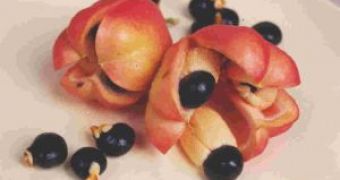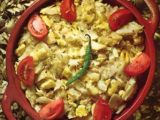If you go to spend your holiday in Jamaica, you will surely believe you're gonna eat fried eggs when they serve the national food: akee.
What is akee?
Something like an avocado: biologically a fruit, gastronomically a vegetable.
Akee tree (Blighia sapida) originates in Western Africa and was brought to Jamaica in XVIIIth century, with the slave ships.
In fact, "akee" seems to come from "ankye", in Akan language, spoken in Ghana.
Akee trees grow up to 15 m (45 feet) tall and are found everywhere in Jamaica, akee being consumed by everybody.
Akee is eaten usually with salted imported codfish, combined with sauce made of onion, piper and other spices.
If codfish lacks, it can be served with any other type of fish, other meats or sole.
Unripe akee fruits are green, but as they mature, they get a shiny reddish tint.
At full maturity, they crack and must be plucked.
When the fruit opens, three funicles can be seen, each having a black seed stuck on their tips.
These pale yellow funicles are eaten, after the removal of the seeds and the reddish stuff from the center of the funicles.
Green or overripe akees are toxic and some children intoxication cases have been recorded.
The symptoms are generally called Jamaican Vomiting Sickness.
Before cracking, the fruit contains two extremely toxic amino acids, called hypoglycins.
These substances interrupt the decomposition of the fatty acids, leading to the accumulation in the blood of toxic short chained acids, which induce sleepiness and coma.
They also impede the formation of glucose in liver.
When unripe fruits are cooked, hypoglycin dissolves in water, that's why cooking water must be thrown away and not be used for cooking another dish.
In countries where with a large number of Jamaican immigrants, canned akee can now be found.

 14 DAY TRIAL //
14 DAY TRIAL // 
